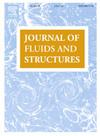Digital twin-empowered investigation on limit cycle flutter of a double-girder bridge section
IF 3.4
2区 工程技术
Q1 ENGINEERING, MECHANICAL
引用次数: 0
Abstract
The investigation of limit cycle flutter (LCF) in a bridge section is currently conducted through the utilization of both wind tunnel testing and numerical simulation techniques, specifically during the design stage of a bridge. In consideration of the drawbacks and uncertainties to both wind tunnel testing and numerical simulations, this paper presents a digital twin-empowered investigation on LCF of a double-girder bridge section. While the computational fluid dynamics (CFD) simulation for the bridge section as a fluid-structure coupling model is viewed as a virtual entity, the wind tunnel testing of the bridge section is considered a physical entity. Based on the multivariate polynomial regression iterative optimization algorithm, the data collected from the physical entity is mingled with the virtual entity to achieve a digital twin of LCF at a given wind velocity. Subsequently, the Kriging interpolation is employed for the purpose of establishing a digital twin system, which is designed to simulate and predict LCF in the bridge section under conditions of wind velocity that have not been tested in the wind tunnel testing or exceed the measurement capacity of wind tunnel test. The findings of this research demonstrate that a digital twin-empowered investigation is feasible and greatly enhances the prediction quality and capacity of LCF of the double-girder bridge section.
双梁桥截面极限环颤振的数字双赋权研究
桥梁截面极限环颤振(LCF)的研究目前主要是通过风洞试验和数值模拟两种技术进行的,特别是在桥梁设计阶段。考虑到风洞试验和数值模拟的缺陷和不确定性,本文提出了一种双梁桥截面LCF的数字双赋权研究方法。将桥梁截面计算流体力学(CFD)模拟作为流固耦合模型视为虚拟实体,而将桥梁截面风洞试验视为物理实体。基于多元多项式回归迭代优化算法,将物理实体采集的数据与虚拟实体混合,实现给定风速下LCF的数字孪生。随后,采用Kriging插值法建立数字孪生系统,用于模拟和预测未进行风洞试验或超过风洞试验测量能力的风速条件下桥梁截面的LCF。研究结果表明,数字孪生赋权研究是可行的,大大提高了双梁桥断面LCF预测的质量和能力。
本文章由计算机程序翻译,如有差异,请以英文原文为准。
求助全文
约1分钟内获得全文
求助全文
来源期刊

Journal of Fluids and Structures
工程技术-工程:机械
CiteScore
6.90
自引率
8.30%
发文量
173
审稿时长
65 days
期刊介绍:
The Journal of Fluids and Structures serves as a focal point and a forum for the exchange of ideas, for the many kinds of specialists and practitioners concerned with fluid–structure interactions and the dynamics of systems related thereto, in any field. One of its aims is to foster the cross–fertilization of ideas, methods and techniques in the various disciplines involved.
The journal publishes papers that present original and significant contributions on all aspects of the mechanical interactions between fluids and solids, regardless of scale.
 求助内容:
求助内容: 应助结果提醒方式:
应助结果提醒方式:


